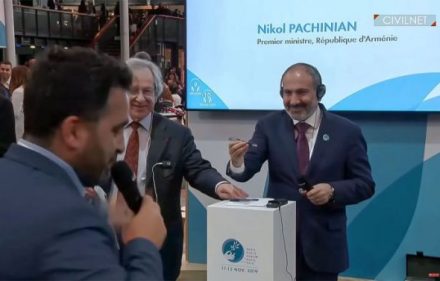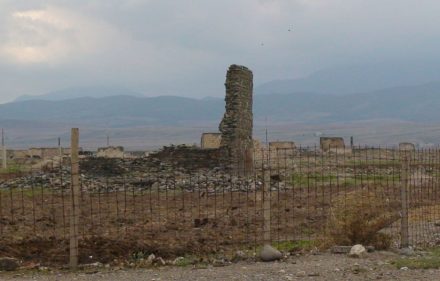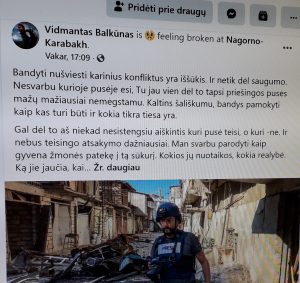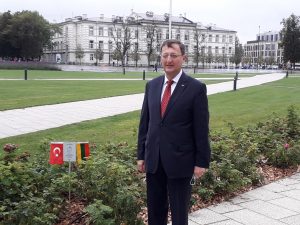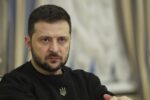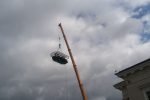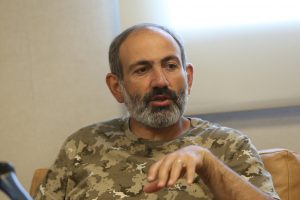
Prime Minister Ingrida Šimonytė, today at the Government palace, will welcome the Prime Minister of the Republic of Armenia Nikola Pashinian, arriving with his delegation.
It is planned that the meeting in Vilnius will discuss the prospects of the bilateral relations between Lithuania and Armenia, the cooperation between EU and Armenia, preparations for 15 December 2021 Eastern Partnership summit in Brussels, regional issues.
It is planned that attention will focus on strengthening cooperation in health sector, reads the statement of the Government press office. Lithuania has already allocated humanitarian aid to Armenia in the fight against Covid-19 pandemic – necessary medical protection equipment, PCR tests, has send medical mission to share good experience, has donated 27 500 Vaxzevria (Astra Zeneca) vaccine doses. Government’s decision, dated 29 September, donates another 50 thousand doses of Moderna’s Spikevax vaccine.
After the meeting of the Prime Ministers, it is planned to sign a cooperation memorandum between Lithuanian and Armenian Health Ministries and hold a joint press conference.
On the same day Šimonytė and Pashinian will attend a concert in Kaunas Philharmony to mark the day of Armenia’s independence and the 30th anniversary of the diplomatic relations between Lithuania and Armenia.
This is what Lithuania’s ELTA news agency reports.
What questions arise after reading these news? Isn’t Lithuania paying too much honor for the leader of the country, who for almost three decades has been occupying 20 percent of foreign territory? Namely, Nagorno Karabakh, which (the Armenian fans would dispute) according to the international law is an inseparable part of Azerbaijan. By the way, Nikola Pashinian, who has come to power several years ago and became the most important leader of Armenia (in Armenia Prime Minister has more power than Armenian President) did not move a finger to peacefully return Karabakh and nearby seven regions, taken in 1988-1994 military operations, to Azerbaijan.
Armenia not only did not return what it had illegally occupied, but also in the second half of 2020 opened fire to Azeri cities, that have nothing to do with Karabakh. Those are Ganja, Tartar and Barda. Below are statistics of those attacks:
‘Between 27 September 2020 and 28 October 2020 alone, Armenian forces opened fire to the cities of Ganja, Tartar, Agdam and villages of those districts, that have nothing to do with Nagorno Karabakh and obviously belong to Azerbaijan. In that month alone, 69 civilian Azeri people have been killed in Azerbaijan by Armenian artillery (322 civilian Azeri persons have been injured). Armenian forces also tried to open fire to Baku-Tbilisi-Ceyhan and Baku-Novorosijsk pipelines, targeted Mingacevir hydro power plant (one of the largest in South Caucasus, destroying it would harm about 100 thousand civilian Azeri people, fortunately, Azerbaijan’s forces managed to neutralize those missiles before they reached the target). Several cases have been recorded when green oil and condensate export pipelines were targeted by fire in Kizi region. By the way, Kizi is about 300 km away from the front line of that time, other civilian Azeri objects, fired at by Armenian forces, are at least 100 km away from disputed Nagorno Karabakh. It should be underlined that Armenia’s attack against Ganja city (the old Azeri capital) will probably go into history as the first case when a country, actively participating in OSCE, used a ballistic missile SCUD/Elbrus against civilian objects in another country, participating in OSCE missions. Cluster bombs have also been used against civilian objects in Azerbaijan, which international conventions strictly forbid. Also, a case has been recorded when an attempt was made to destroy a South Caucasian pipeline by using Smerch 9 M525 missile with 9 N235 bombs’.
We could try and defend Armenia, but it was Pashinian who did not leave Azerbaijan another solution in recapturing Karabakh – only military measures. After Yerevan did not agree to peacefully return Karabakh, Azerbaijan was forced to organize a military liberation operation (it was patiently waiting for three decades already). Azerbaijan carried out the military action in the end of 2020. Turkey, Lithuania’s ally in NATO Alliance, helped Azerbaijan to take back its territories.
That is why I am asking: does Lithuanian Prime Minister Ingrida Šimonytė know at least a little about the history of South Caucasus; has she heard at least a little about to whom Karabakh belongs; has she been informed by advisors about the shootings in Ganja, Tartar and Barda in the autumn of 2020?
Just remember, how in November 2019 Lithuania’s First Lady Diana Nausėdienė in Vilnius welcomed Ana Hakobian, wife of Armenian Prime Minister Pashinian, who allegedly brought some kind of a peace plan to Lithuania.
Lithuania made a big political mistake, because by agreeing to discuss with the wife of a Prime Minister, who is occupying territory of a foreign state, we have undermined the principles of morality and integrity, which we keep demanding from others. We have truly undermined them, because we did not listen to the other side – wife of Azeri President Ilham Aliyev. It would have also been a good idea to invite the wife of the Turkish President and listen to her remarks how to justly regulate the dispute about Karabakh. That is it – Lithuanian First Lady met only with the wife of Armenian leader, and she has not once spoken with wives of leaders of Azerbaijan and Turkey, whose fighter jets have multiple times protected Lithuanian air space. Lithuanian tendencies in the conflict between Azerbaijan and Armenia are obvious. But why?
Recently Lithuania has been very bravely criticizing countries, that act wrong – Russia, Belarus, China. Our remarks and disappointments are correct. But why then we have not spoken a single word against Armenia. Lithuanian Government palace and Kaunas Philharmonic will be entered by a person, who, at least in theory, is responsible for opening fire to the cities of Ganja, Tartar and Barda in the autumn of 2020. Such shootings have an international assessment – war crimes or crimes against humanity.
If Lithuania is honest and principled, maybe we should have first invited to Vilnius the Azeri people, who were hurt in the shootings in Ganja, Tartar and Barda?
Lithuania’s optimistic talks about the Eastern Partnership summit in Brussels on 15 December also look a little strange. Russian military base is deployed in Armenia. It has been deployed for a long time. It will not be easy to get rid of it. Lithuania is naive if it thinks that this factor does not hinder Yerevan from drifting towards Europe. Lithuania pretends it does not know all circumstances how Armenian economy is disturbingly connected to the businesses, led by Russia, governed by Vladimir Putin. Lithuania is stupid if it is convinced that interconnected Armenian-Russian businesses will not hinder Armenia to go towards Europe. Or maybe, someone from Yerevan convinced Lithuania that ‘Lithuania without Armenia, is Lithuania without future?’
By the way, quite recently, by the side of Lithuania, Russia and Belarus held a large military drill Zapad 2021. Representatives of the armed forces of Armenia, together with Russian and Belarussian military, also trained to attack all of the Baltic countries from all sides.
Is Lithuanian Prime Minister ready to discuss at least this subtle issue with Armenian Prime Minister? If you want Lithuanian support, do not dare to participate in such military maneuvers ever again.
2021.10.04; 10:27

